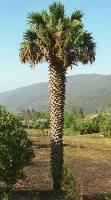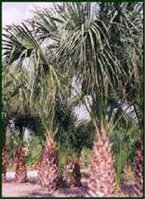Texas Sabal Palm
Tree
Detailed Description
Description
The stately and robust Texas Sabal Palm grows up to 50’ tall with a
solitary trunk, 8-32” in diameter. The canopy of a mature Sabal may be
8-25’ across. The gray trunk has closely spaced annular rings. Usually
part of the trunk remains covered with old leaf stem “boots,” that often
split at their bases. These persistent boots form a characteristic
crosshatch pattern on the trunk. The petioles (leaf stems) are smooth
and completely thornless and may be up to 15’ in length. The Texas Sabal
has 10-25 fan-shaped leaves ranging in color from deep emerald green for
palms in shade or part shade, to lighter green for palms receiving more
sunlight. Each leaf has 80-115 leaflets with characteristic threads
unraveling along the margins. The leaves have prominent and strongly
downward arching costas (leaf midribs) which give them a
three-dimensional effect. The Texas Sabal may flower when very young,
often blooming when the trunk is small or even nonexistent. The Texas
Sabal produces small white flowers in a branched inflorescence about as
long as the leaves. Male and female flowers are borne on the same plant.
The fruits are round-oval and black when ripe. The Texas Sabal can be
distinguished from other palmate-leafed palms by its long, smooth,
nonthorny petioles and the long, downward arching costas.
Usage
Use the Texas Sabal in formal groupings, as a lawn tree, in large-scale
plantings and as that special accent tree. It is best suited to medium
or large yards since it may grow 50’ tall and spread 25’ across. It may
be used in a variety of situations since it is tolerant of wind,
drought, salt, and most soil types.
Features
A very robust, stately and hardy palm, the Texas Sabal is beginning to
receive attention from growers and palm enthusiasts. Once abundant in
Texas, the habitat of the Sabal is now threatened. Its habitat has
diminished from about 40,000 acres in 1925 to about 32 acres today. The
leaves are used for thatching, and making furniture, fans, and hats; and
its rot-resistant trunks are used as fence posts and for pilings in
wharves and piers. The Texas Sabal is one of only two palms native to
Texas, the other being the much smaller blue palm or dwarf
palmetto(Sabal Minor).

